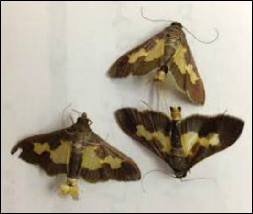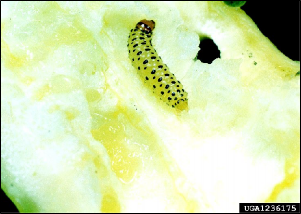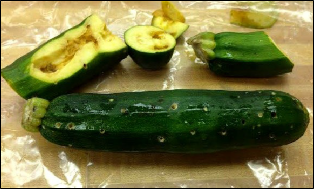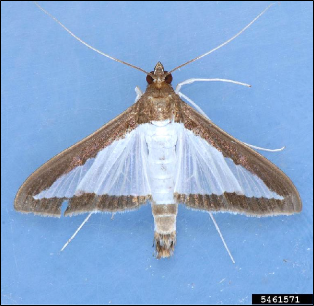Pickleworm
ID
3104-1559 (ENTO-439NP)
Introduction
Pickleworm, Diaphania nitidalis (Stoll), is a moth that belongs to the family Crambidae in the order Lepidoptera.
Description
Adult moths are distinctively colored with a wingspan of about 3 cm (1.2 inches) (Fig. 1). Both the front wings and the hind wings have a central yellow splotch bordered by chocolate brown; the central splotch is somewhat transparent. Legs and antennae are yellowish. Both sexes have a prominent brush of yellow hairs on the tip of the abdomen that serve in pheromone communication.

Young pickleworm larvae are yellowish-white with a brownish head. Young larvae have numerous rows of dark spots, but these disappear with age (Fig. 2). Older larvae are greener and may turn pinkish or coppery as they near pupation. Larval coloration may vary with their food plant. Mature larvae measure 25-30 mm (about 1 inch) long.

Life History
Pickleworm eggs are deposited singly or in small groups on actively growing tissues of the host plant (i.e., shoots, buds, and flowers). Eggs are initially white but turn yellow after about a day and then hatch in about 3-4 days. Larvae may feed on flowers, vines, and fruit, but their preference is for developing leaf or flower buds. Caterpillars molt five times before reaching the adult stage in about 2-3 weeks. Mature larvae pupate in thin cocoons made in leaf folds or plant debris held together with a few strands of silk. Adults emerge in 8-9 days. Adults are nocturnal and tend to remain in weedy or wooded areas adjacent to fields with food plants during the day. An adult female may lay several hundred eggs in her lifetime.
Common Host Plants
Pickleworm feeds on curcubits such as cucumber, squash, pumpkin, muskmelon, cantaloupe, and winter squash. Summer squash is a favored host while watermelon is less preferred. Ornamental gourds and wild curcubits, such as creeping cucumber (Melothria pendula), also serve as host plants.
Damage
Pickleworm larvae burrow into the buds, flowers, and developing fruits of their host plant to feed. Tunneling in buds and flowers limits fruit set, while feeding in fruits ruins them. Caterpillars neatly chew round holes in the host plant; wet, pulpy frass (fecal material) is often found at these entrances (Fig. 3). Feeding injury also encourages the onset of disease, but the presence of pickleworm larvae ruins the fruit for consumption before decay begins. Larvae will attack the central vines once the blossoms and fruits have been eaten.

Distribution
Pickleworm is found in the southeastern United States; into Connecticut, Illinois, and Iowa; and west towards Kansas. Pickleworm is a tropical species that overwinters only in southern Florida and possibly south Texas. It ranges northward via successive generations each year throughout much of the southeastern United States. It tends to arrive in Virginia in late summer and does not always occur every year.
Cultural Control
Plant early using resistant and/or early maturing varieties. Plantings made in very early spring are seldom damaged by pickleworm. Crush or otherwise destroy infested fruit and pupae among leaves whenever found. Destroy vines, unused fruits, other crop residue, and nearby weeds as soon as the crop is harvested. Spading or plowing in the early fall will destroy pickleworm pupae, although pupae are not likely to survive our winters in Virginia.
Green stems infested with pickleworms can be slit open along the vine to remove the caterpillars. Destroy any larvae found so they cannot reinfest the plants. Encourage rooting at the slit by heaping dirt over the injured stem. Because adult pickleworms are not attracted to lights and no pheromone for pickleworm is commercially available, there are no trapping schemes for this species.
Because pickleworm favors summer squash over other types of curcubits, a few plants of summer squash can be used as a sentinel for the arrival of pickleworm in the area. Summer squash can also be used as a trap crop to protect a main crop of a different curcubit.
Organic/Biological Control
Insecticidal soaps and pyrethrins are options for organic control of pickleworm. Kaolin clay sprays may be used as a crop protectant. Certified organic growers should always check that an organic method is approved by their certifier. No biological control agents are known for pickleworm in commercial fields at this time.
Chemical Control
Scout fields and begin treating with a registered insecticide at first sign of larvae in blossoms and buds and before fruit set. Larvae must be killed before they enter the fruit where they are protected from insecticides. For treatment recommendations for pickleworm, see the current Mid-Atlantic Commercial Vegetable Production Recommendations (VCE Publication 456-420) for commercial fields or the Home Grounds and Animals Pest Management Guide (VCE Publication 456-018) for home gardens. As with all pesticides, follow the label instructions carefully with regards to rates and precautions.
Note
Melonworm, Diaphania hyalinata L., is a related species that usually feeds on the foliage of curcubits rather than on buds, flowers, and developing fruits like pickleworm. Adults are similar in appearance to adult pickleworm moths except that there is a large, translucent central marking across the front and hind wings that resembles a rounded pyramid (Fig. 4). Melonworm larvae are a light green with two white parallel lines down the length of the body. Occasionally melonworm larvae will feed on developing fruits, but they feed only on the surface and do not tunnel inside the fruit. Treatment recommendations for melonworm are the same as for pickleworm; see the Commercial Vegetable Production Recommendations for commercial fields or the Home Grounds and Animals Pest Management Guide for home gardens.

Virginia Cooperative Extension materials are available for public use, reprint, or citation without further permission, provided the use includes credit to the author and to Virginia Cooperative Extension, Virginia Tech, and Virginia State University.
Virginia Cooperative Extension is a partnership of Virginia Tech, Virginia State University, the U.S. Department of Agriculture (USDA), and local governments, and is an equal opportunity employer. For the full non-discrimination statement, please visit ext.vt.edu/accessibility.
Publication Date
March 5, 2021



